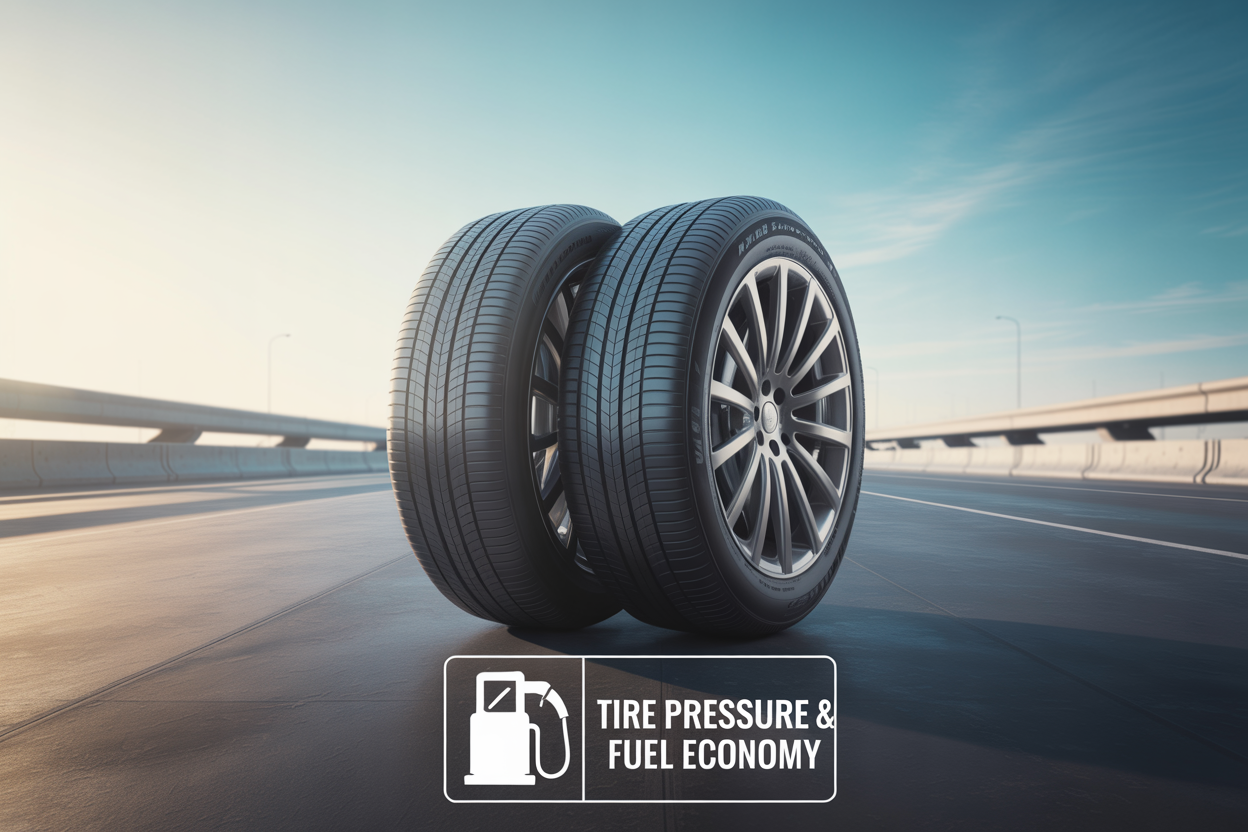There’s a silent thief draining your gas tank right now, and it’s hiding in plain sight. Those slightly soft tires that “look fine” are secretly costing you money with every mile you drive—an invisible tax that adds up to hundreds of dollars each year.
Here’s what the oil companies don’t advertise: for every 1 PSI your tires drop below the recommended pressure, you lose approximately 0.4% in fuel economy. The U.S. Department of Energy reports that properly inflated tires can improve gas mileage by up to 3.3%. That might sound modest, but for the average American driver, it translates to savings of $150-$250 annually—essentially a free tank of gas every few months.
The numbers get worse. Studies show that 85% of drivers don’t know how to properly check tire pressure, and more than half are driving on underinflated tires right now. With gas prices continuing to climb, those soft tires are forcing you to fill up more often while simultaneously wearing out faster—a expensive double penalty.
But here’s the good news: fixing this problem costs nothing and takes less time than waiting for your coffee to brew. No special skills needed, no expensive equipment required. Just a simple gauge and two minutes once a month can put those wasted dollars back in your pocket.
In this guide, we’ll reveal exactly how tire pressure affects your fuel economy, calculate your personal savings potential, and show you the surprisingly simple steps to stop this unnecessary waste. Whether you drive a compact car or a heavy SUV, the physics—and the savings—apply to everyone.
The Science Behind the Savings
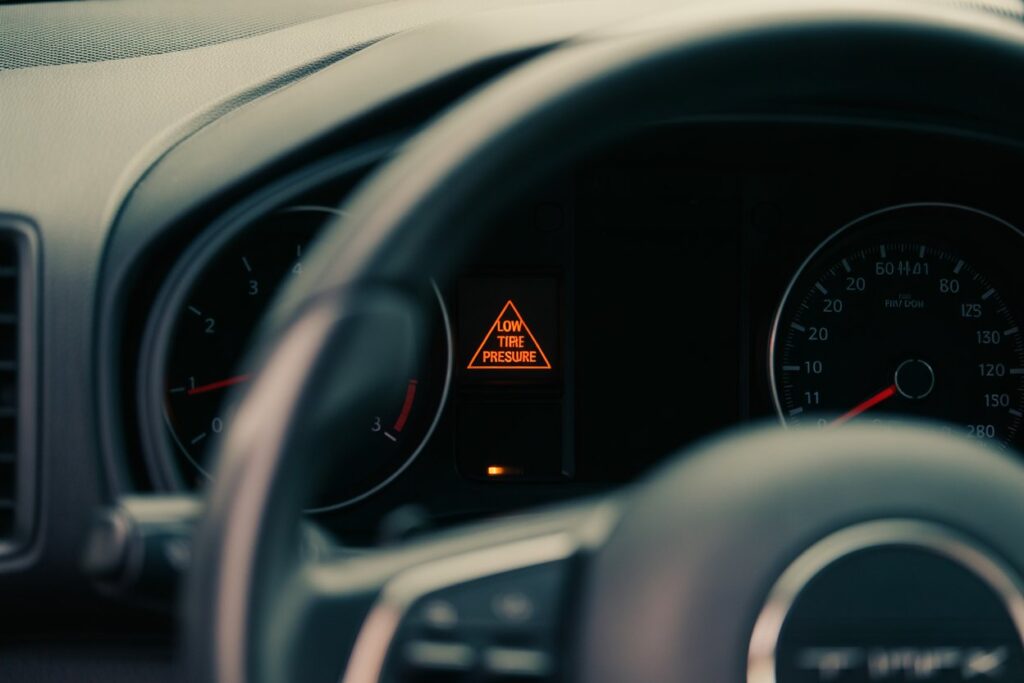
Understanding why tire pressure affects fuel economy isn’t rocket science—it’s simple physics that impacts your wallet every time you drive.
How Rolling Resistance Works
Picture pushing a wheelbarrow with a flat tire versus one properly inflated. The flat tire requires more effort because it creates more friction against the ground. Your car experiences the same struggle. Rolling resistance accounts for about 20% of your vehicle’s fuel consumption at highway speeds, and tire pressure is the biggest factor you can control.
When a tire rolls, it constantly deforms at the contact patch—the small area touching the road. Properly inflated tires minimize this deformation, rolling smoothly like a ball bearing. Underinflated tires flex excessively, creating a larger contact patch that fights forward motion like dragging a rubber mat.
Why Underinflated Tires Burn More Fuel
Every rotation of an underinflated tire involves extra work. The sidewalls flex more dramatically, the tread squirms against the pavement, and internal friction generates heat. Your engine must overcome all this additional resistance, burning more fuel to maintain the same speed.
Think of it like jogging on sand versus pavement—you work much harder for the same distance. At 20% below recommended pressure, your tires create enough extra drag to reduce fuel economy by 10% or more.
The Heat Generation Problem
Underinflated tires don’t just waste fuel—they literally burn energy through heat. Excessive flexing generates temperatures that can exceed 200°F, accelerating tire wear and potentially causing dangerous blowouts. This heat represents pure wasted energy that should be moving you forward.
Optimal Pressure vs Manufacturer Recommendations
Your vehicle manufacturer spent millions determining the ideal pressure for your specific car. This number balances fuel efficiency, handling, comfort, and tire wear. Adding 2-3 PSI above recommendation might save a tiny amount of fuel, but it compromises handling and wears the tire center prematurely. The manufacturer’s specification isn’t a suggestion—it’s the scientifically optimized sweet spot.
The Real Cost of Low Pressure
Let’s translate the science into dollars and cents. The numbers might shock you—underinflated tires cost far more than most drivers realize.
Fuel Economy Loss Per PSI
Research from the National Highway Traffic Safety Administration provides the hard data:
- 1 PSI below recommendation: 0.4% fuel economy loss
- 5 PSI low: 2% loss
- 10 PSI low: 5% loss
- 20% underinflated (about 6-8 PSI): 10% fuel economy penalty
For perspective, driving with tires 5 PSI low is like permanently adding 50 pounds of cargo to your vehicle. You’re hauling invisible weight that serves no purpose except draining your tank.
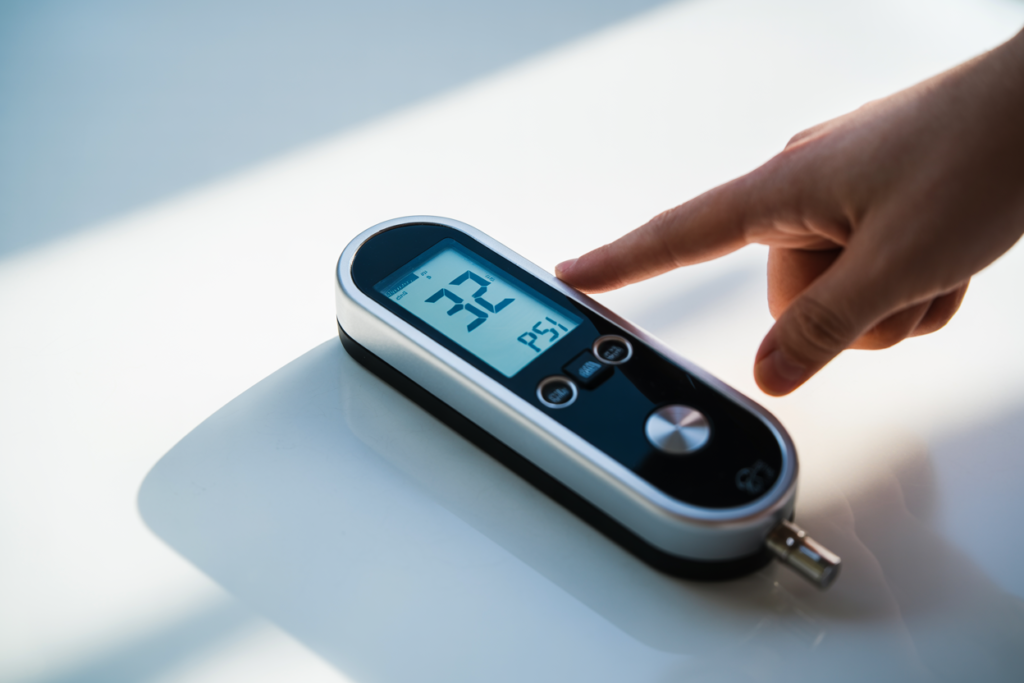
Annual Cost Calculations
Let’s break down the real impact for an average driver:
- Annual miles: 12,000
- Average fuel economy: 25 MPG
- Gas price: $3.50 per gallon
- Annual fuel cost at proper pressure: $1,680
With tires 5 PSI low (2% penalty):
- Reduced fuel economy: 24.5 MPG
- Annual fuel cost: $1,714
- Extra cost: $34 per year
With tires 10 PSI low (5% penalty):
- Reduced fuel economy: 23.75 MPG
- Annual fuel cost: $1,768
- Extra cost: $88 per year
Compound Effects: The Hidden Multiplier
The fuel penalty is just the beginning. Underinflated tires wear 25% faster, meaning a $600 set lasting 60,000 miles now needs replacement at 45,000 miles. That’s $150 in premature tire wear. Add potential suspension damage from excessive tire flex, and the true cost easily doubles.
Case Study: The 5 PSI Reality
Most drivers run 5 PSI low without knowing it. Here’s the five-year cost:
- Extra fuel: $170
- Premature tire replacement: $150
- One prevented flat repair: $25
- Total waste: $345
That’s a car payment thrown away for no reason except neglecting a two-minute monthly check. For families with multiple vehicles, multiply accordingly—many households waste $500+ annually on collective tire neglect.
Finding Your Sweet Spot
Knowing the correct tire pressure for your vehicle isn’t guesswork—it’s precisely documented. Yet most drivers look in the wrong place or trust outdated advice.
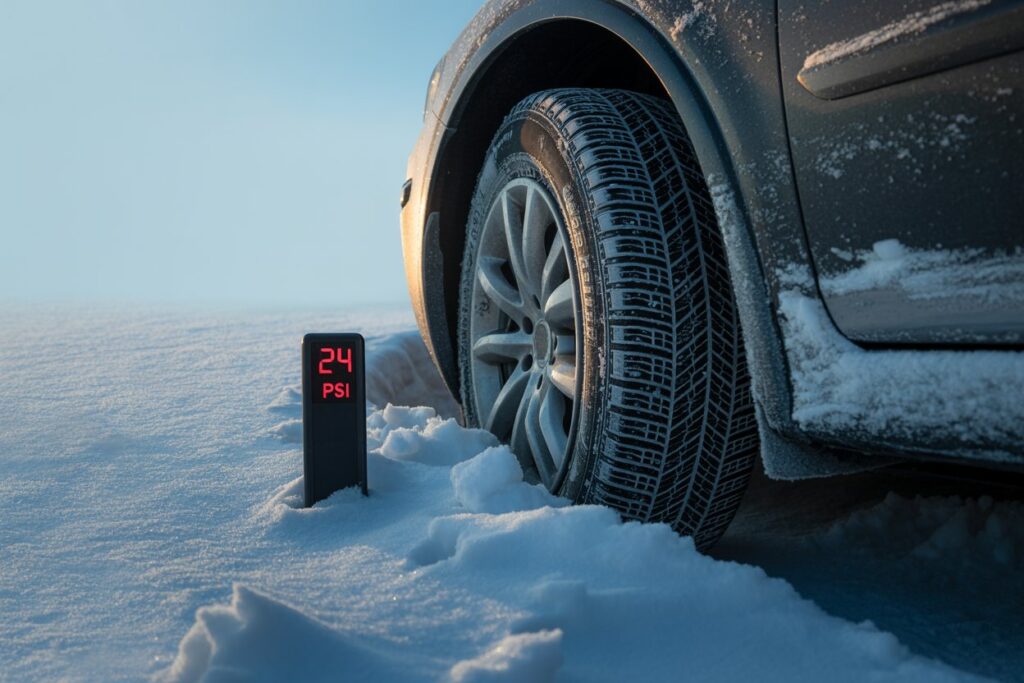
Where to Find Correct Pressure Specs
Your vehicle’s recommended tire pressure appears in three reliable locations:
- Driver’s door jamb: A sticker listing front and rear pressures
- Owner’s manual: Detailed specifications for all scenarios
- Fuel door: Some manufacturers place a reminder here
These numbers reflect your specific vehicle’s weight, suspension design, and intended performance. A Honda Civic needs different pressure than a Ford F-150, even with identical tire sizes.
Cold vs Hot Tire Pressure Readings
Here’s a critical fact: tire pressure specifications assume cold tires. Driving heats tires, increasing pressure by 4-6 PSI. That “perfect” 35 PSI after your commute might only be 29 PSI cold—dangerously low.
Always check pressure:
- In the morning before driving
- After the car sits for at least three hours
- In shaded areas, not direct sunlight
If you must check warm tires, add 4 PSI to the recommended cold pressure as a temporary measure, then recheck when cold.
Why the Tire Sidewall Number Is Wrong
That “MAX PSI 44” molded into your tire sidewall? Ignore it. This indicates the tire’s maximum capacity, not your vehicle’s requirement. Inflating to maximum pressure creates a overinflated, harsh-riding tire with poor traction and center wear.
The sidewall maximum is like a bridge’s weight limit—important for safety, but not the target for normal use. Stick to your vehicle manufacturer’s specification.
Seasonal Adjustments Needed
Temperature changes affect tire pressure dramatically. For every 10°F drop, tires lose about 1 PSI. That first cold morning in October? Your properly inflated summer tires are now 5-7 PSI low.
Seasonal pressure management:
- Fall: Add 2-3 PSI as temperatures drop
- Winter: Check weekly during cold snaps
- Spring: Release excess pressure as temps rise
- Summer: Monitor during heat waves (pressure increases)
Smart drivers check pressure monthly year-round, but seasonal transitions demand extra attention.
Pressure Monitoring Strategies
Modern technology promises to handle tire pressure for us, but smart drivers know that personal vigilance still pays dividends. Here’s how to develop a bulletproof monitoring system.
TPMS Limitations and False Confidence
That tire pressure monitoring system (TPMS) in your dash seems helpful, but it’s not your friend for fuel economy. Federal regulations only require TPMS warnings when pressure drops 25% below recommendation. For a tire spec’d at 32 PSI, the light illuminates at 24 PSI—already costing you serious fuel economy.
TPMS is an emergency warning system, not a maintenance tool. By the time that light appears, you’ve already been wasting fuel and damaging tires for weeks. Think of TPMS like a smoke detector—useful for disasters, not for cooking perfect meals.
Monthly Manual Checking Routine
Successful pressure management requires consistency. Pick a trigger:
- First Saturday of each month
- Every time you pay your car insurance
- When your phone bill arrives
- During regular car washes
The key is linking pressure checks to existing habits. Mark your calendar, set phone reminders, or stick a note on your garage door. Two minutes monthly saves hundreds annually.
Best Time to Check
Morning checks provide the most accurate readings, but any consistent routine beats sporadic checking. The ideal scenario:
- Saturday morning before errands
- Temperature between 60-80°F
- Car parked overnight
- Level ground, not on an incline
Can’t manage morning checks? Evening checks after work still beat nothing. Just ensure the car has cooled for at least three hours.
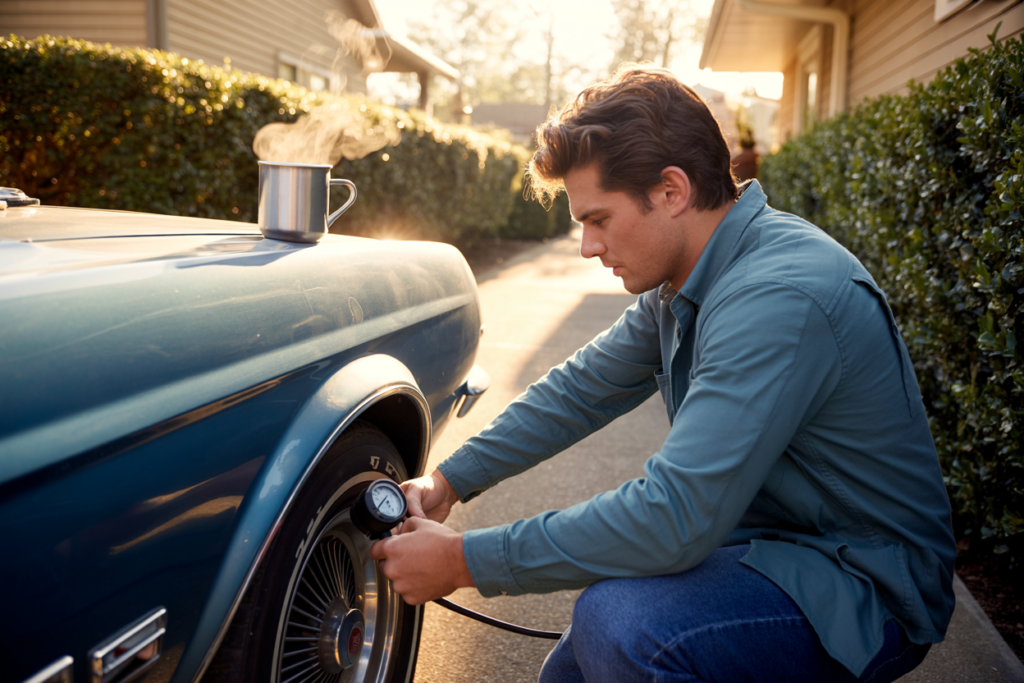
Digital vs Analog Gauges
Gauge accuracy matters when 2-3 PSI makes a real difference:
Digital gauges ($15-25):
- Accuracy within 0.5 PSI
- Easy-to-read display
- Battery dependent
- Best for precision
Analog gauges ($5-15):
- Accuracy within 1-2 PSI
- No batteries needed
- Harder to read precisely
- More durable
Either beats gas station gauges, which suffer from abuse and weather exposure. Invest in a quality personal gauge—it pays for itself in one month of proper inflation.
Beyond Basic Inflation
Once you’ve mastered regular pressure checks, several advanced strategies can maximize your fuel savings and tire performance.

Nitrogen vs Air: Worth the Cost?
Tire shops push nitrogen inflation claiming better pressure retention and fuel economy. The science says otherwise for passenger vehicles:
Nitrogen benefits:
- 3-4% slower pressure loss
- Less moisture inside tire
- Slightly cooler running
Reality check:
- Cost: $5-10 per tire
- Savings: Maybe $5 annually in reduced top-offs
- Inconvenience: Can’t refill anywhere
For most drivers, nitrogen is expensive snake oil. That $40 initial fill buys a premium gauge and years of regular air. Save nitrogen for race cars and aircraft where marginal gains matter.
Load Adjustments for Trips and Cargo
Your door jamb might list two pressures: normal and fully loaded. This isn’t optional—heavy loads require higher pressure to maintain fuel economy and prevent tire damage.
Loading guidelines:
- Road trip with full trunk: Add 3-5 PSI
- Towing: Check owner’s manual (often 5-10 PSI increase)
- Heavy cargo: Use maximum vehicle recommendation
- After unloading: Return to normal pressure
That family vacation with bikes, luggage, and passengers can add 500+ pounds. Without pressure adjustment, you’ll burn extra fuel while risking dangerous tire failure.
Pressure Modifications for Performance
Some drivers experiment with pressure for specific benefits:
- Hypermilers: Add 2-3 PSI for maximum fuel economy
- Comfort seekers: Reduce 1-2 PSI for softer ride
- Performance drivers: Adjust for handling balance
These modifications involve trade-offs. Higher pressure saves fuel but reduces traction and wears centers. Lower pressure improves comfort but costs fuel and wears edges. Unless you’re chasing specific goals, stick to manufacturer specifications.
Electric Vehicle Considerations
EVs present unique pressure challenges:
- Heavier batteries require precise inflation
- Regenerative braking stresses tires differently
- Rolling resistance critically impacts range
- Low pressure can reduce range by 10-15%
EV drivers should be especially vigilant about pressure. That same 5 PSI deficit that costs gas drivers $35 annually might reduce EV range by 20 miles per charge—potentially stranding you short of a charging station.


